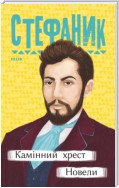Vasyl Stefanyk

Vasyl' Semenovych Stefanyk (1871 — 1936) was a classical Ukrainian prose writer and political activist. He was a member of the Austrian parliament 1908-1918.
Vasyl Stefanyk was born on May 14, 1871 in the village of Rusiv in the family of a well established peasant. He was born in the historical region of Pokuttya, in Austro-Hungary. Today it is part of the Sniatyn Raion, Ivano-Frankivsk Oblast. He died on December 7, 1936 in the same village, Rusiv, at that time the part of Poland.
His primary education Stefanyk obtained in the Sniatyn City school and later studied in Polish gymnasiums of Kolomea and Drohobytsch. He was excluded from the Kolomea gymnasium for participation in a revolutionary circle. Upon graduation from the Drohobytsch gymnasium he enrolled into the Krakow's University (1892). During his student years Stefanyk became acquainted with Oles Martovych and Lev Bachynsky, both of whom had an influence on his life: Les turned him to writing, and Lev steered him toward community-political involvement. Later, while he was a student of medicine at Jagiellonian University Collegium Medicum in Krakow, Stefanyk was befriended by the Polish Doctor Wacław Moraczewski and his wife, Doctor Sofia Okunevska, who acquainted him with contemporary European culture and literature and with the members of the then-fashionable Polish avant-garde group Młoda Polska, particularly with Stanisław Przybyszewski, Władysław Orkan and Stanisław Wyspianski. The hectic and interesting Bohemian life is reflected in Stefanyk's letters, in which references to the works of modernist authors, such as Charles Baudelaire, Gottfried Keller, Paul Verlaine, Maurice Maeterlinck, and Paul Bourget, abound. Stefanyk's letters, full of poetic prose, lyricism, and introspection, also provide glimpses of the future master of the short story in the various narrative vignettes. Attempts to publish some of the introspective poetic prose in newspapers were unsuccessful, but in 1897 the terse narratives of scenes observed by Stefanyk appeared in Pratsia (engl- Work) (-NL--Chernivtsi); they were followed by several novellas in Literaturno-naukovyi vistnyk (The Literally-scientific informer, 1898) and finally by Stefanyk's first collection of novellas, Synia knyzhechka (The Blue Book, 1899). With its appearance came the immediate literary acclaim, and other collections followed: Kaminnyi khrest (The Stone Cross, 1900), Doroha (The Road, 1901), and Moye slovo (My Word, 1905). Eventually he quit his schooling in 1900.In 1901 Stefanyk was at the height of his literary career, but for the next 15 years he wrote nothing. Upon the arrival to Poltava on the opening of the monument to Ivan Kotliarevsky in 1903 he was met by the members of Ukrainian intelligentsia as the accomplished national writer. From 1908 until the collapse of the Austro-Hungarian Empire in 1918, Stefanyk was a member of the Austrian parliament, elected as a substitute for Volodmyr Okhrymovych in 1907 from the Ukrainian Radical party in Galicia. The horror of the First World War jolted him back into writing in 1916, and he produced one more collection, Zemlia (Earth, 1926). During the period of the Western Ukrainian National Republic, as a former member of parliament, Stefanyk became the vice-president of the Ukrainian National Rada, and in 1919 he went to Kiev for the signing of the agreement with the Ukrainian National Republic on the unification of Ukraine. In 1922 he became the district head of the Ukrainian Radical party. Recognizing him as the greatest living writer in western Ukraine, the government of Soviet Ukraine decreed a life pension for Stefanyk, which he turned down in protest against the repressions in Ukraine. In addition to his five collections of novellas, Stefanyk published stories, in several editions of collected works: an edition in 1927 in Soviet Ukraine; a jubilee edition (Lviv 1933); an émigré edition edited by his son, Yurii Stefanyk (Regensburg 1948); and the three-volume academic edition, published in Ukrainian SSR (1949–54). The 1964 edition of Stefanyk's selected works, edited by Vasyl Lesyn and Fedir Pohrebennyk, complemented and corrected some of the lacunae and faults of the academic edition. The "Blue Book" was republished in Ukraine in 1966 in an edition lavishly illustrated by Mykhaylo Turovsky.
 čeština
čeština Deutsch
Deutsch français
français magyar
magyar polski
polski русский
русский English
English Azərbaycan
Azərbaycan беларуская
беларуская italiano
italiano ქართული
ქართული қазақ
қазақ Nederlands
Nederlands português
português slovenčina
slovenčina español
español 中文
中文 українська
українська










